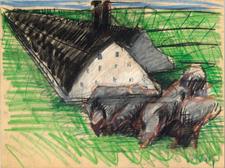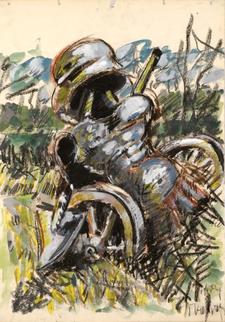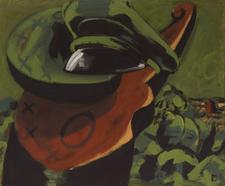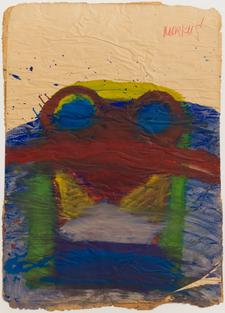
Kunstmuseum Schloss Derneburg is pleased to announce an exhibition of works on paper by German artist, poet, and musician Markus Lüpertz, one of the most important and influential artists to emerge from post-war Germany. Featuring approximately 40 early works that focus on the artist’s output between 1964-1976, the show traces the development of Lüpertz’s idiosyncratic iconography. Known primarily for his large-scale paintings and sculptures, Lüpertz has made thousands of preparatory drawings throughout his six-decade career. This survey, which includes celebrated subjects like Donald Duck, railway tracks, tree trunks, and soldiers, allows an intimate overview of some of Lüpertz’s most important themes, and features works that have not been publicly exhibited in more than forty years.
Lüpertz moved to West Berlin in 1962 at the age of 21. Shortly thereafter, the artist developed an approach to image making around the genre of the “dithyramb,” a Dionysian idea revived by Nietzsche which refers to choric hymns characterized as passionate or ecstatic. The method emphasized spontaneity and framed Lüpertz’s approach to images as a poetic endeavor akin to literary form. The artist published the “Dithyrambic Manifesto” in 1966, in which he famously stated, “the dithyramb that I invented makes the charm of the twentieth century visible.” Lüpertz’s joining of Cold War era abstraction with mainstream, commercial, or banal subjects remains the foundation of his intellectual approach to painting and sculpture.
Ahead of an exhibition in Cologne in 1969, Lüpertz visited a section of the Siegfried Line located in a rural area on the western border of the FDR. Referred to in German as the “West Wall,” the fortified boundary comprised of bunkers, trapezoidal tank barriers, and abandoned tanks is still partially existent today. In the drawing Ohne titel – dithyrambisch, (1970 ca.), a herd of sheep graze in front of a farmhouse with a black, triangular thatched roof. The shape of the barns recalls the visual obstruction of the Siegfried Line which when viewed from above resembled a railroad track cutting through the terrain. By juxtaposing pastoral landscape with manmade interventions, Lüpertz’s drawings suggest various overlapping histories related to agricultural initiatives, military intervention, and national propaganda.
The exhibition also features drawings produced during preparations for the first Berlin Art Biennale in 1974, which Lüpertz helped found. In a series of studies, including Schwarz-Rot-Gold (ca. 1974), Lüpertz combines his still life and landscape compositions, arranging symbols in a vertical form that suggests the absent figure of a soldier. In place of the figure, the props remain: helmet, wooden wheel, spade, and armor, abandoned in the field. The primary subject of this series, later produced in large scale paintings, raises questions about individual identity within ideological constructs.
This major presentation of drawings is supplemented by critical paintings, including Arrangement für eine Mütze (1973), in which Lüpertz overlaps various elements in a still-life arrangement within a natural but surreal landscape. The discernible forms include a Wehrmacht military cap, a painter’s palette, a guitar, and a snail shell embedded in the receding hills. The symbols have various connotations, for example the guitar relates in art history to both Picasso’s cubist collages as well as the female form. Furthering this provocation, by incorporating a Wehrmacht hat into a cubist composition, Lüpertz directly referenced a style condemned by the Nazi party as “degenerate.” At the time, this subject exploration was often received as neo-Fascist, a criticism lobbied at Lüpertz and his contemporaries, including Georg Baselitz, A.R. Penck, Gerhard Richter and Anselm Kiefer, who were considering similar questions. In retrospect, it was each of these artists’ dedication to performative and/or illustrative taboos that forced a reconciliation with postwar identity by a new generation of artists.
Markus Lüpertz (b. 1941, Bohemia) lives and works in Berlin and Düsseldorf, Germany. His work has been exhibited extensively since 1973, including recent surveys at the Haus der Kunst, Munich; Palazzo Loredan, Venice; Hirshhorn Museum and Phillips Collection, Washington DC; the Musée d’Art Moderne de la Ville de Paris; Kunst- und Austellungshalle der Bundesrepublik Deutschland, Bonn; Gementeemuseum, The Hague, and the Hermitage State Museum, St. Petersburg.
For more information and images, please contact the Hall Art Foundation’s administrative office at info@hallartfoundation.org.
The exhibition is only accessible by guided tour.

Markus Lüpertz
Ohne titel - dithyrambisch, ca. 1970
Crayon and colored chalk on paper
16-1/2 x 22 in. (42 x 56 cm)
Hall Collection. Courtesy Hall Art Foundation
© 2023 VG Bild-Kunst, Bonn

Markus Lüpertz
Schwarz-Rot-Gold, ca. 1974
Gouache, crayon on paper
27 x 19-1/4 in. (68.5 x 49 cm)
Hall Collection. Courtesy Hall Art Foundation
© 2023 VG Bild-Kunst, Bonn

Markus Lüpertz
Arrangement für eine Mütze, 1973
Distemper on canvas
52-1/4 x 68 in. (133 x 173 cm)
Hall Collection. Courtesy Hall Art Foundation
© 2023 VG Bild-Kunst, Bonn

Markus Lüpertz
Ohne titel / zu Donald Duck - dithyrambisch, 1963/64
Tempera and mixed media on layered packing paper
38 x 27 in. (96.5 x 68.5 cm)
Hall Collection. Courtesy Hall Art Foundation
© 2023 VG Bild-Kunst, Bonn